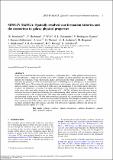SDSS-IV MaNGA : spatially resolved star-formation histories and the connection to galaxy physical properties
Abstract
A key task of observational extragalactic astronomy is to determine where – within galaxies of diverse masses and morphologies – stellar mass growth occurs, how it depends on galaxy properties and what processes regulate star formation. Using spectroscopic indices derived from the stellar continuum at ∼4000Å, we determine the spatially resolved star-formation histories of 980000 spaxels in 2404 galaxies in the SDSS-IV MaNGA IFU survey. We examine the spatial distribution of star-forming, quiescent, green valley, starburst and post-starburst spaxels as a function of stellar mass and morphology to see where and in what types of galaxy star formation is occurring. The spatial distribution of star-formation is dependent primarily on stellar mass, with a noticeable change in the distribution at M*>1010M⊙. Galaxies above this mass have an increasing fraction of regions that are forming stars with increasing radius, whereas lower mass galaxies have a constant fraction of star forming regions with radius. Our findings support a picture of inside-out growth and quenching at high masses. We find that morphology (measured via concentration) correlates with the fraction of star-forming spaxels, but not with their radial distribution. We find (post-)starburst regions are more common outside of the galaxy centre, are preferentially found in asymmetric galaxies, and have lower gas-phase metallicity than other regions, consistent with interactions triggering starbursts and driving low metallicity gas into regions at <1.5Re.
Citation
Rowlands , K , Heckman , T , Wild , V , Zakamska , N L , Rodriguez-Gomez , V , Barrera-Ballesteros , J , Lotz , J , Thilker , D , Andrews , B H , Boquien , M , Brinkmann , J , Brownstein , J R , Hwang , H-C & Smethurst , R 2018 , ' SDSS-IV MaNGA : spatially resolved star-formation histories and the connection to galaxy physical properties ' , Monthly Notices of the Royal Astronomical Society , vol. Advance article . https://doi.org/10.1093/mnras/sty1916
Publication
Monthly Notices of the Royal Astronomical Society
Status
Peer reviewed
ISSN
0035-8711Type
Journal article
Description
Funding: V. W. acknowledges support from the European Research Council Starting Grant SEDmorph (P.I. V. Wild).Collections
Items in the St Andrews Research Repository are protected by copyright, with all rights reserved, unless otherwise indicated.
Related items
Showing items related by title, author, creator and subject.
-
SDSS-IV MaNGA: How the stellar populations of passive central galaxies depend on stellar and halo mass
Oyarzún, Grecco A.; Bundy, Kevin; Westfall, Kyle B.; Tinker, Jeremy L.; Belfiore, Francesco; Argudo-Fernández, Maria; Zheng, Zheng; Conroy, Charlie; Masters, Karen L.; Wake, David; Law, David R.; McDermid, Richard M.; Aragón-Salamanca, Alfonso; Parikh, Taniya; Yan, Renbin; Bershady, Matthew; Sánchez, Sebastián F.; Andrews, Brett H.; Fernández-Trincado, José G.; Lane, Richard R.; Bizyaev, D.; Boardman, Nicholas Fraser; Lacerna, Ivan; Brownstein, J. R.; Drory, Niv; Zhang, Kai (2022-07-06) - Journal articleWe analyze spatially resolved and co-added SDSS-IV MaNGA spectra with signal-to-noise ratio ∼100 from 2200 passive central galaxies (z ∼ 0.05) to understand how central galaxy assembly depends on stellar mass (M*) and halo ... -
Secular-and merger-built bulges in barred galaxies
Mendez Abreu, Jairo; Debattista, V. P.; Corsini, E. M.; Aguerri, J. A. L. (2014-12) - Journal articleContext. Historically, galaxy bulges were thought to be single-component objects at the center of galaxies. However, this picture is now questioned since different bulge types with different formation paths, namely classical ... -
Galaxy And Mass Assembly (GAMA) : galaxy close pairs, mergers and the future fate of stellar mass
Robotham, A. S. G.; Driver, S. P.; Davies, L. J. M.; Hopkins, A. M.; Baldry, I. K.; Agius, N. K.; Bauer, A. E.; Bland-Hawthorn, J.; Brough, S.; Brown, M. J. I.; Cluver, M.; De Propris, R.; Drinkwater, M. J.; Holwerda, B. W.; Kelvin, L. S.; Lara-Lopez, M. A.; Liske, J.; Lopez-Sanchez, A. R.; Loveday, J.; Mahajan, S.; McNaught-Roberts, T.; Moffett, A.; Norberg, P.; Obreschkow, D.; Owers, M. S.; Penny, S. J.; Pimbblet, K.; Prescott, M.; Taylor, E. N.; van Kampen, E.; Wilkins, S. M. (2014-11-11) - Journal articleWe use a highly complete subset of the Galaxy And Mass Assembly II (GAMA-II) redshift sample to fully describe the stellar mass dependence of close pairs and mergers between 10(8) and 10(12)M(circle dot). Using the analytic ...

